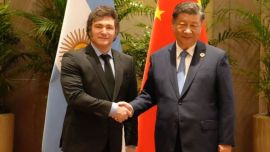An official exchange rate, a 'blue' dollar, a soy dollar, a bond-linked dollar – Argentina’s capital controls were already a headache for private companies but more drastic measures obliging them to restructure their debts has delivered an even harder blow.
In an economic crisis aggravated by the Covid-19 pandemic with an accelerated loss of international reserves, there are no doubts about Argentina’s urgent need to boost exports. The government’s target is to rise from US$65 billion to US$100 billion annually.
But still, a favourable business climate is lacking.
Apart from the tight limitations on individuals acquiring foreign currency, the government has announced that private companies owing over US$1 million abroad must reschedule 60 percent of those liabilities.
"That means the Central Bank won’t sell them the dollars. The problem is that the interest rate floor is set by the country risk index (1,350 points)," economist Matías Rajnerman of Ecolatina firm told AFP.
The alternatives for companies are either to fall into default or to refinance their dollar debts at 13 percent interest rates, he explained.
According to economist Héctor Rubini of Universidad del Salvador, "that hurts the average export company, which needs to import inputs, but they are the target group on whom economic revival in the next decade depends."
‘Defensive position’
The Central Bank measure covers private debt payments for the next six months through to March. The total sum is US$1.253 billion, according to a report by Moody's credit rating agency.
"The corporate sector will have to face a closed debt market or assume financing costs in dollars incompatible with local profit levels. In this context we understand that Argentine companies will take up a defensive position, significantly reducing their expansion plans and reviewing their cost structures," said the investor firm.
Argentina’s gross international reserves have fallen by over US$10 billion in recent years to stand at some US$41 billion currently. But analysts estimate that liquid reserves are closer to US$5 billion.
Since currency controls were installed last year, the gap between the official and black market exchange rates has yawned ever wider.
Lisandro Gordó, a farmer producing soy, maize, wheat, sorghum, barley and peas in Buenos Aires Province, thinks that the big difference between the exchange rates cannot last long.
"No investor is going to bring in a dollar for 75 pesos [the official exchange rate] when it’s worth 145 pesos [on the black market]. What generally happens is that the floor of the official exchange rate goes up," Gordó told AFP.
Furthermore, he maintains that in such contexts "importers over invoice and exporters underbill."
Shutting out imports
Gordó is worried now because he knows that "when any government runs out of dollars, it shuts out imports" and sowing, he maintains, needs products which are acquired abroad.
"Next year the agrochemicals will be coming in at the free exchange rate but even then, we cannot stop sowing the fields," the farmer argued, lamenting that the country has failed to develop all its agricultural capacity.
Apart from multiple exchange rates, Gordó questions the tax burden at all levels, national, provincial and municipal, which he calculates at 70 percent of a farmer’s income.
"Around 10 years ago, Argentina and Brazil produced the same quantity of soy. Today Argentina is stuck on around 50 million tons a year and Brazil produces over 100 million tons," he gave as an example.
Argentina has at least seven different exchange rates.
related news
by Nina Negrón, AFP
























Comments